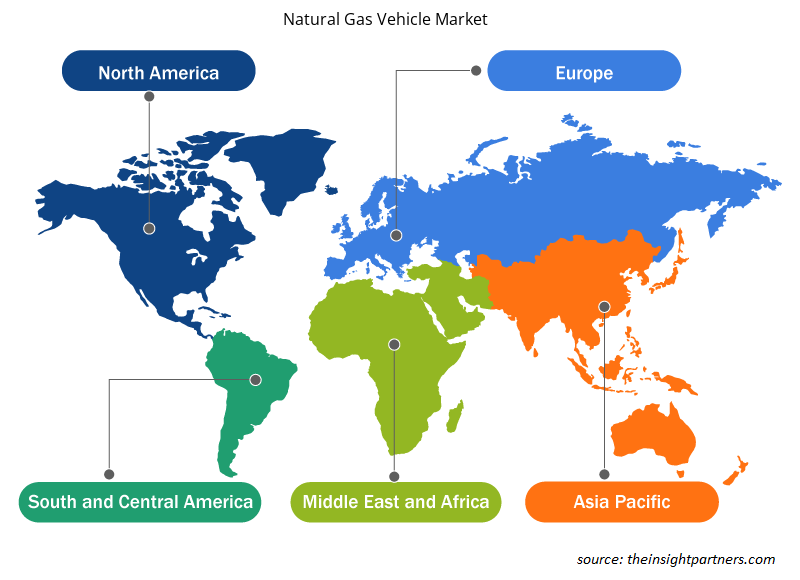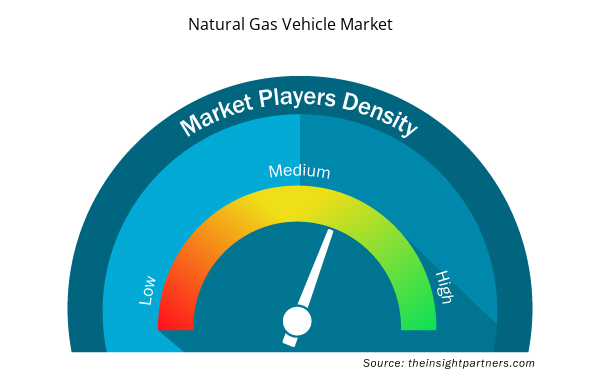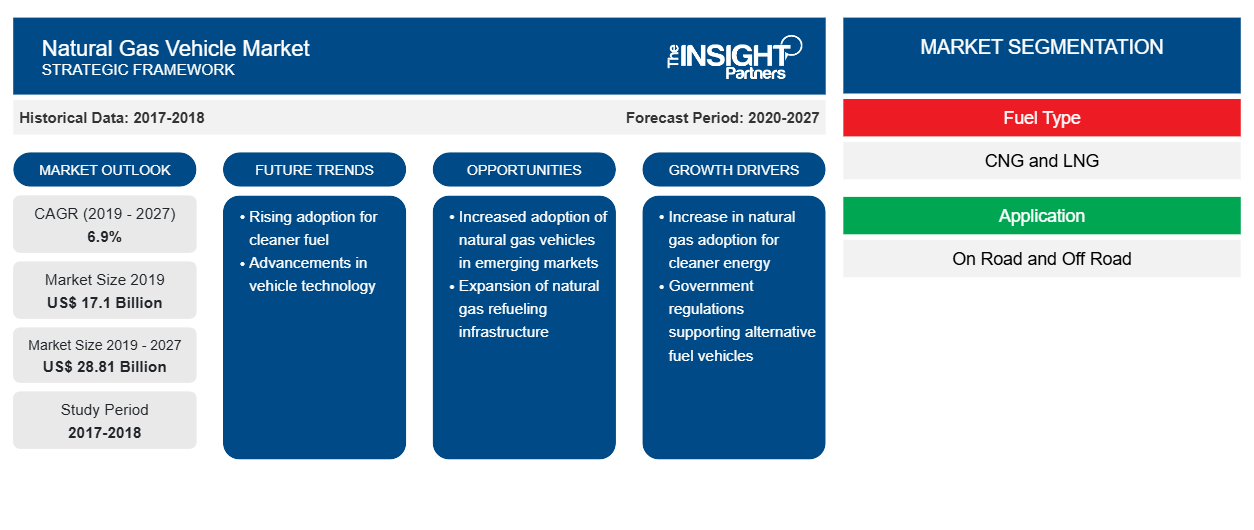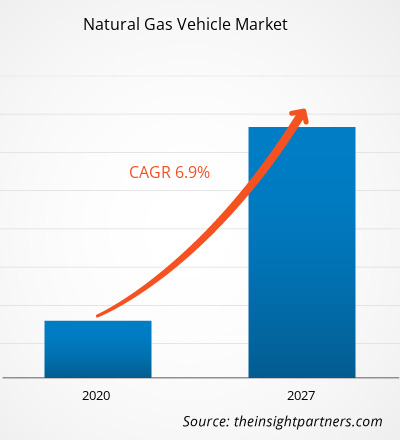2019 年天然气汽车市场价值为 171 亿美元,预计到 2027 年将达到 288.0575 亿美元;预计 2020-2027 年期间的复合年增长率为 6.9%。
天然气汽车发动机的功能类似于汽油驱动的汽车发动机,后者通常是火花点火式内燃机。天然气储存在气缸或燃料箱中,通常嵌入车辆后部。电池为这些车辆的发动机和电力电子设备的运行提供电力。电子控制模块 (ECM) 控制点火正时、燃料混合物和排放系统;它还观察车辆的运行并检测问题。天然气是一种环保燃料,因为它比汽油或柴油造成的污染更少,而且其资源在世界各地广泛可用。此外,使用天然气汽车的潜在好处包括温室气体排放低、成本降低、噪音降低和当地空气质量改善。根据气候技术中心和网络 (CTCN) 的数据,压缩天然气 (CNG) 被广泛用作全球汽车燃料。CTCN 表示,约 75 个国家/地区有约 1000 万辆天然气驱动汽车和约 15,000 个 CNG 加气站。在天然气储量丰富而石油储量有限的国家,在交通运输中使用天然气可以降低对昂贵的石油进口的依赖。全球天然气汽车市场目前是一个利基市场,因为目前少数国家的公路运输中天然气的份额很小。在车辆中使用 CNG 的主要国家是巴基斯坦、阿根廷、伊朗和巴西。
建立天然气汽车市场可能需要对汽车进行大量投资并增加政府支持,因为许多国家不太可能在普及程度较低的情况下实现天然气汽车市场。全球汽车行业蓬勃发展,乘用车和商用车产量迅速增加。此外,将天然气的好处扩展到汽车行业以外的更广泛的行业,将吸引更多对天然气供应输配电网的投资。
定制此报告以满足您的需求
您可以免费定制任何报告,包括本报告的部分内容、国家级分析、Excel 数据包,以及为初创企业和大学提供优惠和折扣
- 获取此报告的关键市场趋势。这个免费样品将包括数据分析,从市场趋势到估计和预测。
COVID-19 疫情对天然气汽车市场的影响
汽车制造和运输行业严重依赖体力劳动。由于全球大多数国家实施了严格的封锁规定,该行业在各自的制造工厂中劳动力数量显着减少。这一因素阻碍了汽车和运输行业的发展,从而抑制了天然气汽车市场的增长。由于政府加大对天然气汽车基础设施建设的支持,美国是天然气汽车的主要市场。该国 COVID-19 确诊病例和报告死亡人数迅速增加,对汽车和运输行业产生了不利影响。美国、加拿大和墨西哥的工厂和企业关闭限制了对天然气汽车的需求。北美拥有大量制造业和汽车公司;因此,COVID-19 疫情对北美市场的影响相当严重,并且很可能在 2021 年持续下去。
市场洞察–天然气汽车市场
政府更加重视加强能源安全
能源安全意味着持续提供具有成本效益的能源。它具有许多特点,例如长期能源安全,主要处理及时投资以根据环境需求和经济发展提供能源。短期能源安全围绕能源系统对供需平衡的意外变化做出快速反应的能力。巴基斯坦政府通过各种政策措施鼓励在运输行业引入和开发 CNG 应用。巴基斯坦道路上行驶着大量天然气车辆(约 200 万辆),每年消耗 25 亿立方米 (BCM) 的天然气。亚洲各国,尤其是印度,已在石油、天然气、煤炭和电力领域引入了重要的能源定价改革,这对于进一步开放能源市场和改善其财务状况至关重要。印度已采取重大措施,通过促进天然气汽车的国内生产来发展其能源安全。随着人们对使用化石燃料对环境的影响以及能源网的好处的担忧日益增加,工程师们正在逐步采用能源存储解决方案,从而推动能源安全行业的发展。采用天然气作为交通燃料以降低碳排放有助于实现可持续发展目标,同时解决全球能源安全问题。因此,各国政府对加强能源安全的关注度不断上升,推动了天然气汽车市场的增长。
基于燃料类型的见解
根据燃料类型,天然气汽车市场分为 CNG 和 LNG。由于天然气汽车数量不断增加,全球对 CNG 汽车的偏好日益增加,CNG 汽车市场继续见证着有利可图的机会。此外,汽车行业的增长影响着 CNG 汽车的采用。
基于应用的见解
根据应用,天然气汽车市场分为公路和越野两大类。2019 年,公路领域引领市场。天然气主要用于发电和住宅、商业和工业应用。它被用作公路车辆的燃料,尤其是集中加油车队中的中型或重型车辆。也有人提议将其更广泛地用作公路车辆的燃料,尤其是轻型车辆。
基于车辆类型的洞察
根据车辆类型,天然气汽车市场分为乘用车、轻型商用车和重型商用车。2019 年,乘用车领域引领市场。乘用车是印度 CNG 和 LPG 汽车市场的领先领域。印度顶级汽车制造商更注重天然气汽车的发展,而不是电动汽车。由于人均收入的增加和对奢侈品的需求,对乘用车的需求正在增加。公众对天然气乘用车的接受和政府的大力支持将推动天然气汽车市场的增长。
天然气汽车市场区域洞察
Insight Partners 的分析师已详尽解释了预测期内影响天然气汽车市场的区域趋势和因素。本节还讨论了北美、欧洲、亚太地区、中东和非洲以及南美和中美洲的天然气汽车市场细分和地理位置。

- 获取天然气汽车市场的区域具体数据
天然气汽车市场报告范围
| 报告属性 | 细节 |
|---|---|
| 2019 年市场规模 | 171亿美元 |
| 2027 年市场规模 | 288.1亿美元 |
| 全球复合年增长率(2019 - 2027) | 6.9% |
| 史料 | 2017-2018 |
| 预测期 | 2020-2027 |
| 涵盖的领域 | 按燃料类型
|
| 覆盖地区和国家 | 北美
|
| 市场领导者和主要公司简介 |
|
市场参与者密度:了解其对商业动态的影响
天然气汽车市场正在快速增长,这得益于终端用户需求的不断增长,而这些需求又源于消费者偏好的不断变化、技术进步以及对产品优势的认识不断提高等因素。随着需求的增加,企业正在扩大其产品范围,进行创新以满足消费者的需求,并利用新兴趋势,从而进一步推动市场增长。
市场参与者密度是指在特定市场或行业内运营的企业或公司的分布情况。它表明在给定市场空间中,相对于其规模或总市场价值,有多少竞争对手(市场参与者)存在。
在天然气汽车市场运营的主要公司有:
- 沃尔沃集团
- 敏捷燃料解决方案
- 康明斯西港公司
- 福特汽车公司
- 帕卡公司
免责声明:上面列出的公司没有按照任何特定顺序排列。

- 了解天然气汽车市场顶级关键参与者概况
市场参与者专注于新产品的创新和开发,通过在其产品中集成先进的技术和功能来与竞争对手竞争。
- 2020 年,Agility Fuel Solutions 敦促印度汽车和车队行业实施 CNG 长途旅行解决方案。印度石油和天然气部长在由印度最大的 CNG 分销公司 Indraprastha Gas Limited (IGL) 领导的一项战略计划下推出了印度首款长途压缩天然气 (CNG) 公交车。
- 2020 年,PACCAR Inc. 被环境报告公司 CDP 评为全球环境实践领导者。该公司凭借其商用车业务和全球工厂中一流的温室气体披露和减排能力而入选榜单。
天然气汽车市场 – 按燃料类型
- 天然气
- 液化天然气
天然气汽车市场 – 按应用分类
- 在路上
- 越野
天然气汽车市场 – 按车型
- 乘用车
- 轻型商用车
- 重型商用车
天然气汽车市场 – 公司简介
- 沃尔沃集团
- 敏捷燃料解决方案有限责任公司
- 美国本田摩托车公司
- 凯斯纽荷兰工业公司
- 康明斯西港
- 通用汽车
- 纳威司达公司
- 帕卡公司
- 福特汽车公司
- 大众汽车公司
- 历史分析(2 年)、基准年、预测(7 年)及复合年增长率
- PEST 和 SWOT 分析
- 市场规模价值/数量 - 全球、区域、国家
- 行业和竞争格局
- Excel 数据集


- Sweet Potato Market
- Thermal Energy Storage Market
- 3D Mapping and Modelling Market
- Non-Emergency Medical Transportation Market
- Smart Parking Market
- Online Exam Proctoring Market
- Foot Orthotic Insoles Market
- Fertilizer Additives Market
- Water Pipeline Leak Detection System Market
- Travel Vaccines Market

Report Coverage
Revenue forecast, Company Analysis, Industry landscape, Growth factors, and Trends

Segment Covered
This text is related
to segments covered.

Regional Scope
North America, Europe, Asia Pacific, Middle East & Africa, South & Central America

Country Scope
This text is related
to country scope.
Trends and growth analysis reports related to Automotive and Transportation : READ MORE..
The List of Companies - Natural Gas Vehicle Market
- AB Volvo
- Agility Fuel Solutions
- Cummins Westport Inc.
- Ford Motor Company
- PACCAR Inc.
- General Motors
- CNH Industrial N.V.
- Navistar, Inc.
- Volkswagen AG
- Nissan Motor Co., Ltd.
The Insight Partners performs research in 4 major stages: Data Collection & Secondary Research, Primary Research, Data Analysis and Data Triangulation & Final Review.
- Data Collection and Secondary Research:
As a market research and consulting firm operating from a decade, we have published and advised several client across the globe. First step for any study will start with an assessment of currently available data and insights from existing reports. Further, historical and current market information is collected from Investor Presentations, Annual Reports, SEC Filings, etc., and other information related to company’s performance and market positioning are gathered from Paid Databases (Factiva, Hoovers, and Reuters) and various other publications available in public domain.
Several associations trade associates, technical forums, institutes, societies and organization are accessed to gain technical as well as market related insights through their publications such as research papers, blogs and press releases related to the studies are referred to get cues about the market. Further, white papers, journals, magazines, and other news articles published in last 3 years are scrutinized and analyzed to understand the current market trends.
- Primary Research:
The primarily interview analysis comprise of data obtained from industry participants interview and answers to survey questions gathered by in-house primary team.
For primary research, interviews are conducted with industry experts/CEOs/Marketing Managers/VPs/Subject Matter Experts from both demand and supply side to get a 360-degree view of the market. The primary team conducts several interviews based on the complexity of the markets to understand the various market trends and dynamics which makes research more credible and precise.
A typical research interview fulfils the following functions:
- Provides first-hand information on the market size, market trends, growth trends, competitive landscape, and outlook
- Validates and strengthens in-house secondary research findings
- Develops the analysis team’s expertise and market understanding
Primary research involves email interactions and telephone interviews for each market, category, segment, and sub-segment across geographies. The participants who typically take part in such a process include, but are not limited to:
- Industry participants: VPs, business development managers, market intelligence managers and national sales managers
- Outside experts: Valuation experts, research analysts and key opinion leaders specializing in the electronics and semiconductor industry.
Below is the breakup of our primary respondents by company, designation, and region:

Once we receive the confirmation from primary research sources or primary respondents, we finalize the base year market estimation and forecast the data as per the macroeconomic and microeconomic factors assessed during data collection.
- Data Analysis:
Once data is validated through both secondary as well as primary respondents, we finalize the market estimations by hypothesis formulation and factor analysis at regional and country level.
- Macro-Economic Factor Analysis:
We analyse macroeconomic indicators such the gross domestic product (GDP), increase in the demand for goods and services across industries, technological advancement, regional economic growth, governmental policies, the influence of COVID-19, PEST analysis, and other aspects. This analysis aids in setting benchmarks for various nations/regions and approximating market splits. Additionally, the general trend of the aforementioned components aid in determining the market's development possibilities.
- Country Level Data:
Various factors that are especially aligned to the country are taken into account to determine the market size for a certain area and country, including the presence of vendors, such as headquarters and offices, the country's GDP, demand patterns, and industry growth. To comprehend the market dynamics for the nation, a number of growth variables, inhibitors, application areas, and current market trends are researched. The aforementioned elements aid in determining the country's overall market's growth potential.
- Company Profile:
The “Table of Contents” is formulated by listing and analyzing more than 25 - 30 companies operating in the market ecosystem across geographies. However, we profile only 10 companies as a standard practice in our syndicate reports. These 10 companies comprise leading, emerging, and regional players. Nonetheless, our analysis is not restricted to the 10 listed companies, we also analyze other companies present in the market to develop a holistic view and understand the prevailing trends. The “Company Profiles” section in the report covers key facts, business description, products & services, financial information, SWOT analysis, and key developments. The financial information presented is extracted from the annual reports and official documents of the publicly listed companies. Upon collecting the information for the sections of respective companies, we verify them via various primary sources and then compile the data in respective company profiles. The company level information helps us in deriving the base number as well as in forecasting the market size.
- Developing Base Number:
Aggregation of sales statistics (2020-2022) and macro-economic factor, and other secondary and primary research insights are utilized to arrive at base number and related market shares for 2022. The data gaps are identified in this step and relevant market data is analyzed, collected from paid primary interviews or databases. On finalizing the base year market size, forecasts are developed on the basis of macro-economic, industry and market growth factors and company level analysis.
- Data Triangulation and Final Review:
The market findings and base year market size calculations are validated from supply as well as demand side. Demand side validations are based on macro-economic factor analysis and benchmarks for respective regions and countries. In case of supply side validations, revenues of major companies are estimated (in case not available) based on industry benchmark, approximate number of employees, product portfolio, and primary interviews revenues are gathered. Further revenue from target product/service segment is assessed to avoid overshooting of market statistics. In case of heavy deviations between supply and demand side values, all thes steps are repeated to achieve synchronization.
We follow an iterative model, wherein we share our research findings with Subject Matter Experts (SME’s) and Key Opinion Leaders (KOLs) until consensus view of the market is not formulated – this model negates any drastic deviation in the opinions of experts. Only validated and universally acceptable research findings are quoted in our reports.
We have important check points that we use to validate our research findings – which we call – data triangulation, where we validate the information, we generate from secondary sources with primary interviews and then we re-validate with our internal data bases and Subject matter experts. This comprehensive model enables us to deliver high quality, reliable data in shortest possible time.


 获取此报告的免费样本
获取此报告的免费样本